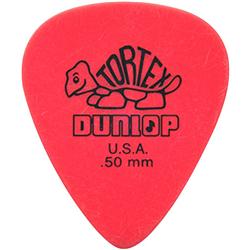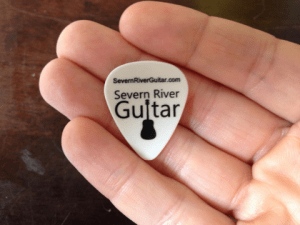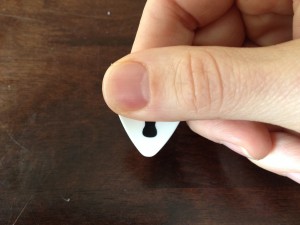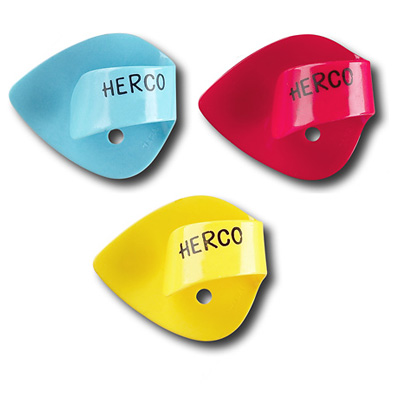This post may contain affiliate links. Please read my disclosure for more info.
UGH! This sucks. Not only do my fingers hurt from pressing down strings, but the pick keeps slipping every time I start to get into a nice strumming pattern. I thought I was making progress!!
Yeah, it’s a bummer. But it’s pretty easy to fix. Here are a few recommendations.
What Kind of Pick are You Using?
With so many different styles of music, and so many different kinds of guitars, it only makes sense that there would be a ton of different kind of guitar picks (sometimes referred to as plectrums). Here, we are going to focus probably the most widely available and (arguably) the most popular picks. They are usually made out of plastic, look like little triangles with rounded edges, and vary in thickness. They look like this:

Generally, picks start to slip and slide around when you start strumming (as opposed to picking out individual notes… though that happens too).
Our focus here will be on strumming. Let’s use the above pick as an example. The above pick is relatively thin (.50 mm). Thin picks are floppy.
I prefer something a little thicker when strumming on an acoustic guitar (.70 mm – .80 mm, or a “medium” thickness). It comes down to personal preference, and there isn’t really a right or wrong size…usually.
However, I find that thinner picks are usually easier to control when you’re a beginner guitar player.
Thicker picks have a tendency to slide around as you start to strum.
Are You Holding Your Pick Correctly?

Now that we’ve got our pick identified, let’s make sure you’re holding it correctly.
There are a few ways you can hold your pick – and oddly enough, the type of music you play may have an impact on how you hold your pick.
For example, if you want to play those awesome quick notes of Gypsy Jazz players, you’ll be using a super thick pick (like the thickness of a big button that’s been kind of shaved down) and it will be kind of clenched in your fingers.
But we’re not doing that here.
So how should you hold your picks? Like this:

The other side should look like this:

Make sure there is a little bit of plastic showing. Here’s another view:

Keep in mind – there are tons of different techniques and ways of holding your pick. I’ve found that this variation is pretty common, easy to do, and a great way for beginners to get started.
Ok. Now that we’ve got our grip down, we need to figure out how hard to squeeze.
This will largely depend on the song, style, or volume of music you’re playing.
For our purposes, I’d suggest starting out by pinching the pick so that if you actually pinched your forearm with the same tension – it would only barely start to hurt.
Got it?
Ok.
Now…
How Are You Strumming?
I think in most cases, the pick will slip and slide around because we’re not really strumming very well. When the pick hits your guitar strings, it should be at about a 45 degree angle.
If you strum at a lower angle the picks will barely hit the strings and it will be tough to get a good sound.
On the other hand, if the pick hits the strings at a right angle you’re going to have a lot of trouble strumming. In this case you will meet a lot of resistance when you’re pick hits the strings.
It’s this resistance that causes your pick to move around.
Whether you’re using down strums or up strums, try to hit the strings at a 45 degree angle.
This can take a bit of practice. Here are two analogies I like:
1. Compare your strum to a paint brush stroke. Rather than striking the strings, think more about quickly and gently brushing up and down on the guitar strings. This requires a little movement in your elbow (as you strum), but also rotation in your forearm, almost like you were…
2. Turning a doorknob. This is my favorite analogy. Put your arm out and pretend like you are turning an imaginary doorknob. See how your whole forearm rotates? Now keep performing that motion and start to bring your forearm to your body (like you are about to strum a guitar). Now bend your elbow up and down while still rotating your forearm. Try to get the timing so that when your elbow comes up, your forearm rotates so that the pick is pointing to your chest. When the elbow goes down, your pick is pointing to your belt buckle/waist.
Try not to be too robotic about it… though it may take a bit of practice.
Where is your Pick Pointing?
The last suggestion I have has to do with the direction your pick is pointing.
Try to have the pointy part of the pick pointing slightly towards the bridge of the guitar.
I’ve found that pointing your pick in this direction gives you better leverage, which in turn prevents the pick from slipping around in the opposite direction.
This leverage also gives you better control over how hard or soft you grip the pick, which makes your playing more dynamic.
Or… Try this Quick Fix…
Even now, after playing guitar for 20 years, I still slip up.
It’s normal.
When it happens just move the pick back into place. The important thing is to become comfortable and used to the way the pick feels in your fingers – so when it starts to slip, you’ll notice and be able to make a quick adjustment.
Or…
You can buy picks that are sort of textured and grippy. Something like Jim’s Pick (my full review of these grippy guitar picks is available here).
Or you can take some sandpaper and roughen up your picks.
Or maybe even just glue a little but of fine-grit sandpaper to your picks. No harm.
Another solution is to try out these awesome Herco picks …

I love these little guys and used to use them exclusively when playing live acoustic music. I suggest the medium thickness (the heavy ones were too bulky and the light ones seemed to break more frequently).
I used them because I did a lot of finger picking mixed with strumming and these picks allowed me to do both really easily. I also like them because they do a great job of training your fingers to nice way of holding your pick. Try them out, they’re only like $1 or something.
That’s it! I’d love to hear what you think – if you agree or disagree. Let me know!
UPDATE: I have a few open spots for Online Guitar Lessons email me if you’re interested at jake@jakeposko.com
22 replies on “My Guitar Pick Keeps Slipping Out of My Fingers (or How to Hold a Guitar Pick)…”
[…] know that your fingers get sweaty when you play (because your guitar pick slips around). Now imagine your friend’s sweat all over the pick that YOU just borrowed… AND […]
Thanks man. The technique tips were very helpful.
[…] also have trouble with slipping guitar picks and playing bar […]
I’m a carpenter who is taking up the guitar. I had a terrible time with the slipping. My fix………double sided carpet tape! Buy a roll at any hardware store, cut a small piece to cover both sides of the pick, Wah Lah! No more slipping! ( Hint, keep the paper an cover the pick when not in use ) Good luck! Brian May is the man!
Awesome idea! Thanks for the tip (especially like the part about keeping the paper on… smart!)
[…] 1. Make sure you’re holding the pick correctly. I go into detail about that here. […]
Thank you so much, your pictures of how to hold the pick correctly have helped me to strum better. Now my pick stays in place!
I’m relatively new to guitar and this is something I’ve been trying to overcome (pick moving) I don’t know if I coined a term or not but I call it pick maintenance . pick maintenance is after a few plucks or strums you need to move your fingers to get the pick back in position. it’s easier if it hasn’t moved much thus pick maintenance comes into play. if you let it go to far you are going to miss a few beats getting it back. Pick maintenance seems to be loosen your grip on the pick and let the string move the pick up or down to get it back into position but you have to keep it up or the pick will move to far
Hey Peter – I think I get what you’re saying… but to clarify, is this when strumming or plucking individual strings?
Peter really appreciate your comment here. It’s a great example of how the best person to learn from isn’t an expert, it’s a fellow learner (because experts don’t remember all the details of how they progressed). I am finding you are right. It seems like what works for me is if the pick sticks a bit to my thumb, but the finger underneath which is applying pressure, is a little free to move around and adjust – as you call it, pick maintenance. For me, my hands are most often dry, so this works best with glossy picks like a celluloid. Glossy only means slick if you’re sweaty. If you’re dry, it means grip!
You’re right Mark – after awhile you kind of forget certain aspects. After reading your comment I realize that I often adjust my pick while strumming (but I don’t even realize I’m doing it anymore). Thanks for the insight!
Read about a glue to hold a thumb pic secure while you strum. The thumb pic always slips on the up stroke and is very tough to adjust. Has anyone else ever heard of this glue ? supposed to apply about 15 minutes or so before playing
Sounds weird… never heard of it…. do you have a link?
I have used double face tape from the hardware store. (Sticky on both sides) You just need a small piece, it stays sticky for quite a while, plus adds a little thickness to the top of the pick which helps keep it in place.
Slick picks is the best way to keep your pick from slipping and more. Period. It is new, so new it’s only available via kickstarter at the moment. However it is a revolution that has waited over 114 years to happen.
[…] of my guitar-related questions, my answer is an obnoxious: “It depends…” (see: this, and this, and […]